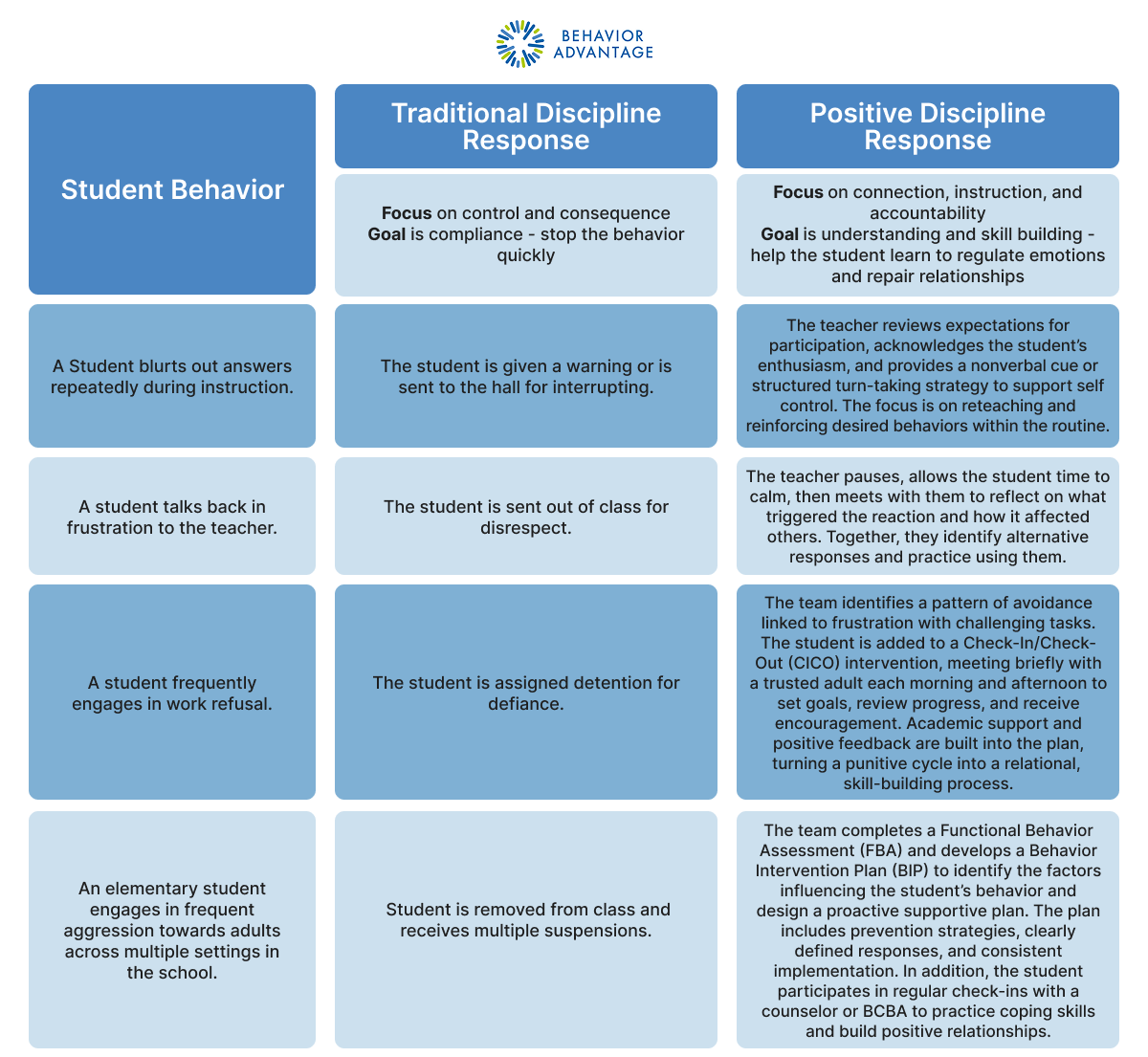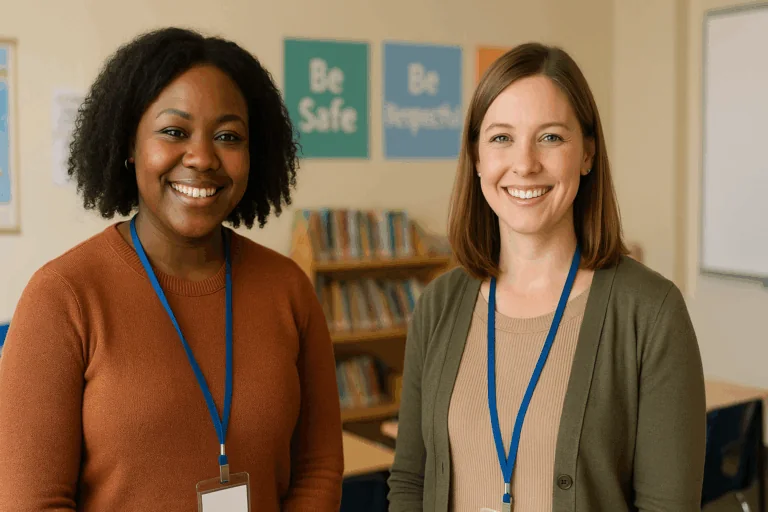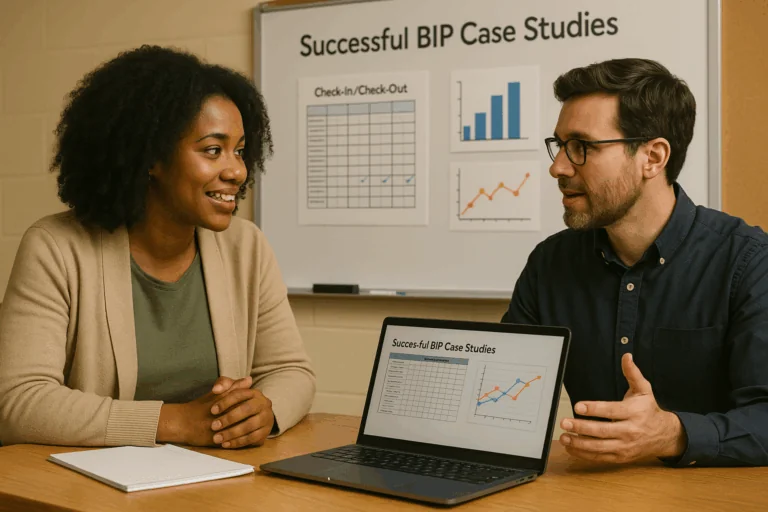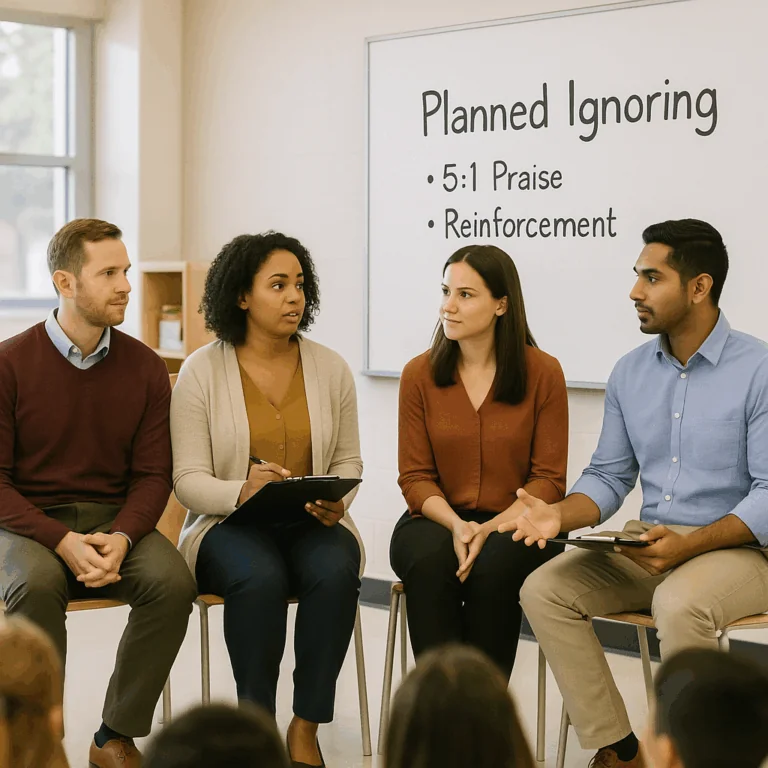From Managing to Teaching Behavior
How do we help teachers move from managing behavior to teaching it – without adding another initiative to their plate?
That question sits at the heart of positive discipline. It’s not about being permissive or abandoning accountability; it’s about shifting our focus from control to connection, from compliance to skill-building. When students learn what’s expected, why it matters, and how to repair mistakes, they develop the self-regulation, empathy, and problem-solving skills that support success well beyond the classroom.
This shift requires more than classroom strategies – it calls for a consistent, systemwide approach. One that equips educators with clear expectations, supportive frameworks, and data-driven tools to track progress across all tiers.
What Is Defining Positive Discipline: Teaching Behavior Through Connection
Positive discipline is an evidence-based approach to behavior that emphasizes teaching and guidance over punishment or control. It’s grounded in the understanding that behavior is learned – and therefore teachable – just like any academic or social skill. This approach helps students develop self-regulation, responsibility, and empathy by focusing on connection, consistency, and accountability.
Rather than enforcing compliance through consequences, positive discipline encourages educators to identify the root cause of behavior, model problem-solving, and guide students in making more positive choices. It shifts the focus from control to connection and from punishment to skill-building, reinforcing the idea that discipline is most effective when it teaches rather than excludes.
When schools establish frameworks that promote safety, consistency, and belonging—such as those grounded in PBIS and MTSS principles—they create the conditions where positive discipline can truly take root. This integration moves behavior support beyond isolated classroom practices, helping entire systems respond to students with empathy, instruction, and accountability.
In practice, positive discipline:
- Teaches behavior through connection, not control.
- Focuses on identifying root causes rather than assigning blame.
- Builds responsibility and self-regulation through consistent guidance.
- Aligns naturally with PBIS and MTSS to promote systemwide consistency.
Rethinking Discipline: From Punishment to Teaching
Positive discipline builds on the understanding that children learn best when they feel safe, supported, and respected. It replaces control and exclusion with guidance and connection, creating environments where every student can learn from mistakes and build essential skills.
When schools apply these principles consistently across classrooms, positive discipline becomes part of the culture – not just a classroom practice.
What this shift looks like in practice:

This approach doesn’t remove responsibility – it redefines it. Students still experience consequences, but those consequences are reasonable, respectful, related, and helpful, guiding them toward better choices rather than simply penalizing mistakes.
Why It Matters: Building Safe and Supportive Systems
Positive discipline doesn’t just impact individual classrooms – it shapes the culture of entire schools and districts. When leadership invests in frameworks that prioritize teaching over punishment, they help create environments where educators and students alike can thrive.
Positive discipline:
- Helps children develop responsibility, self-discipline, problem-solving skills, and cooperation – skills that translate into better academic and social outcomes across all tiers of support.
- Respects both adults and children by promoting mutual understanding and dignity in every interaction – an essential foundation for consistent practices districtwide.
- Builds trust and strengthens relationships, supporting healthy brain development and reinforcing the sense of safety every learner needs to succeed.
- Maintains self-esteem, teaches emotional regulation, and promotes healthy stress management – skills that foster resilience and reduce behavioral escalation.
- Invites children to feel significant, contribute meaningfully, and recognize that they can influence what happens in their lives – mirroring the empowerment districts strive to cultivate in their staff and systems.
When districts build systems that reflect these principles, they move from managing behavior to developing it – creating consistency, confidence, and connection at every level.
Five Criteria for Effective Discipline
According to the Positive Discipline framework, effective discipline meets five key criteria that promote both learning and connection:
It begins by helping children feel a strong sense of belonging and significance, reinforcing that they are valued members of their classroom and school community.
It is mutually respectful and encouraging, maintaining clear expectations while showing empathy – being kind and firm at the same time.
Effective discipline also looks beyond the moment, focusing on long-term growth by considering what the child is learning, how they feel, and how they’ll respond in future situations.
It intentionally teaches essential social and life skills such as respect, empathy, cooperation, problem-solving, and community contribution – skills that extend far beyond behavior correction.
Finally, it invites children to see themselves as capable and responsible, encouraging them to use their personal power constructively and develop confidence in their ability to make positive choices.
Understanding the principles of positive discipline is one thing – putting them into action is another. The strategies below show what this approach looks like in real classrooms, where connection, consistency, and respect turn challenges into teachable moments.

Practical strategies
Strategy 1: Look for Solutions That Are “Reasonable, Respectful, Related, and Helpful”
When challenging behavior occurs, the goal isn’t to control or remove – it’s to teach and restore. For example, if a student reacts disruptively, such as yelling, refusing to follow directions, or walking out of class, a traditional response might be removal or detention. A positive discipline approach instead helps the student understand the why behind the behavior and how it impacts others.
Using a Social Behavior Mapping (SBM) Template is a simple, structured way to guide that reflection. Together, the teacher and student identify:
- The behavior that occurred
- How it affected others
- The natural outcomes or feelings that followed
This process keeps the response related to the incident, respectful of the student’s voice, and helpful in building self-awareness and social problem-solving skills. It transforms a moment of disruption into a teachable opportunity – one that supports growth, not punishment.
Strategy 2: The 2×10 Strategy – Connect Before Correct
The 2×10 strategy is simple but powerful: for two minutes each day, over ten consecutive school days, an educator has a one-on-one conversation with a student. The goal isn’t to talk about behavior or academics – instead, it’s purely relational: ask a question, listen, and show genuine interest. After the first ten days, the educator continues this connection at least once per week.
Why it matters:
- It builds rapport and trust, making students feel seen, valued and heard – so when correction is needed, the relationship is strong enough to support it.
- It shifts the lens from “What’s wrong with you?” to “How are you doing?” – which aligns directly with the connection-over-control philosophy of positive discipline.
- Reduces disruptions, improves adult-student interactions, and supports proactive, not reactive, behavior systems.
Want to find out more? Watch a brief explanation here: 2×10 Strategy – YouTube
Strategy 3: Embed routines and structure.
Predictability reduces anxiety and misbehavior. When students know what to expect, they can focus more on learning and less on uncertainty. Consistent expectations across classrooms – supported by clear, district-wide systems – help every student feel safe, confident, and capable.
You can learn more about how this strategy plays out in a classroom setting here: Structure & Routine – Video
When routines and expectations are consistent across classrooms, they don’t just support individual teachers – they strengthen the entire system. Predictable structures and shared practices create alignment, allowing positive discipline to move beyond isolated strategies and become part of how schools operate every day.
Sustaining Positive Discipline Through Systems and Support
The move toward positive discipline goes beyond classroom practice – it’s about creating the structures that make meaningful connection possible across an entire system. When schools share the same language, expectations, and framework for responding to behavior, consistency becomes the foundation for lasting change.
Structures like aligned data systems, coaching, and ongoing professional learning help ensure educators can respond to behavior in ways that teach, not just correct. These supports turn individual strategies into collective habits, allowing positive practices to take root and grow across classrooms, schools, and districts.
When leadership prioritizes connection and consistency, positive discipline becomes more than an approach to behavior – it becomes part of the culture.
The practice of positive discipline reflects the core belief shared by Behavior Advantage: that lasting behavior change grows through connection, consistency, and collaboration. By aligning with PBIS and providing ongoing professional development and coaching, Behavior Advantage helps schools make positive discipline a sustainable, systemwide practice.
Ready to join the work?
Explore how Behavior Advantage helps districts and educators align PBIS and positive discipline through practical tools, professional development, and connection-focused strategies.
Want see how systems built on connection create lasting change for students and staff?
Take advantage of our free resources or











